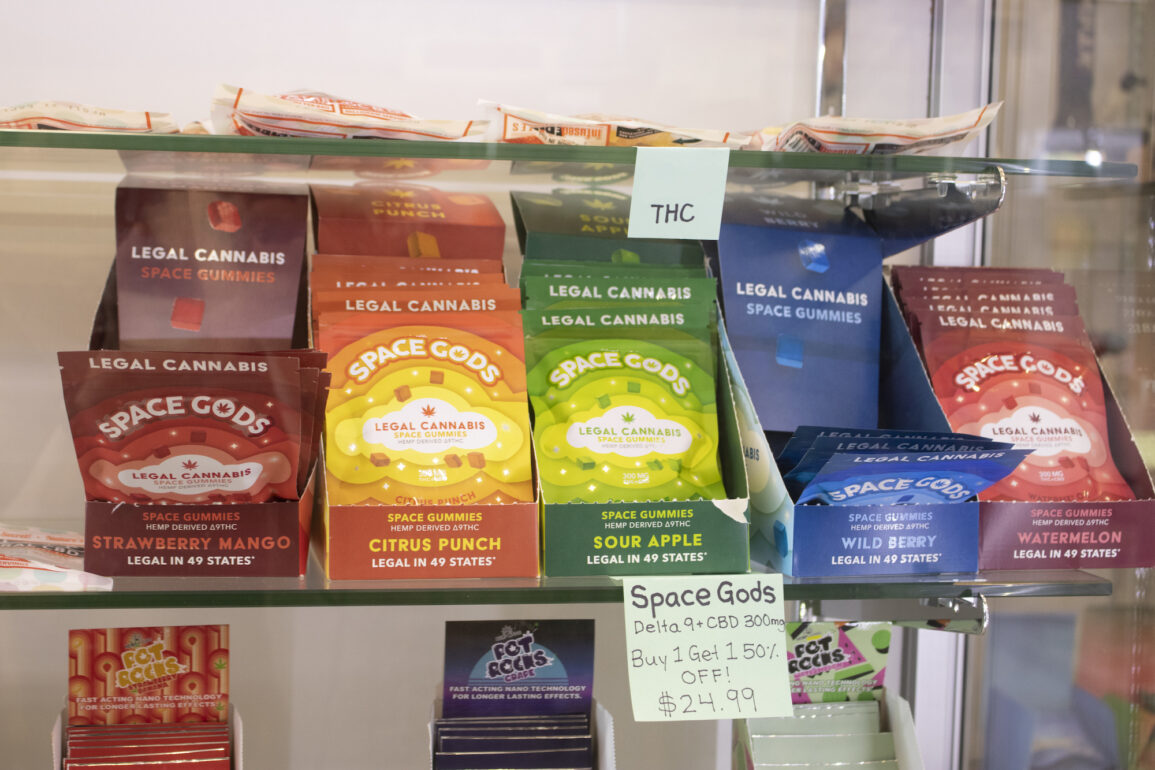The cannabinoid trends have come full circle. After CBD hit the mainstream, hemp companies realized there was a lot of potential in delta-8 THC, and around that time, tons of new contenders popped up, including delta-10, THC-O, THC-P and HHC, but one familiar name has come back around to dominate the industry: delta-9 THC. It’s the only cannabinoid that’s been specifically made illegal, but through the specific definitions used in the bill that resurrected the hemp industry, companies have found a way to get it on the market, apparently legally.
But are these companies reliable? If a customer buys a “hemp delta-9” product, are they going to get what they expected? Do they really fall within legal limits? And are the dosages involved safe?
To answer these questions, we’ve purchased 53 of the most popular hemp-derived delta-9 THC products, and sent them to an independent lab for testing, including both potency testing and checks for impurities or leftovers from the manufacturing process. We’ve also consulted experts in the legalities, practicalities and science of the hemp delta-9 industry to get to the root of both the problems with the industry and their solutions.
Table of Contents
The Results: What We Learned About Hemp Delta-9
Hemp Delta-9 Products Can Far Exceed the Potency of Cannabis Products
The Majority of Hemp Delta-9 Companies Offer COAs
75% of Hemp Delta-9 Products Are Not Tested for Impurities
Most Companies Use ISO Accredited Labs
Half of Companies Use DEA Certified Labs
Fewer Than Half of Products Have a Batch Label
Most Products Don’t Have the Cannabis Universal Symbol
Very Few Companies Use Child Resistant Containers
Checkout Age Verification is Rare
Only One Product Required an Adult Signature on Delivery
Almost All Products Fall Within the 0.3% Delta-9 THC Limit
45% of Products Gave Smaller Dosages Than Advertised
Most Products Converted CBD into THC to Reach Their High Levels
Safety Testing: Hemp Delta-9 Products Are Free From Contaminants
Discussion: What Do The Results Mean? And What Should We Do About It?
What Needs to Be Done About Hemp Delta-9?
Executive Summary
Our lab analysis reveals that while most hemp delta-9 products (96%) fall within the limits set by the 2018 Farm Bill, slightly over half varied substantially from their advertised dosage. The dosages were also much higher than the allowable dosages for edibles in legal states, some 3.7-fold higher than the maximum allowed in states like Colorado or California. Although they often claim to be natural, 64% of products used THC that had been chemically converted from CBD.
On the positive side, all products tested for safety were found to be free from pesticides, residual solvents, heavy metals and other contaminants. However, 75% of products were not tested for this by their manufacturers. Additionally, age restriction was lax, with 85% of products being purchased without age verification at checkout, and 98% being delivered without the need for an adult signature. Regulations are urgently needed to address these issues.
- 1,800 total hemp delta-9 SKUs: We estimate that there are 120 brands currently selling hemp delta-9 products online, for an estimated 1,800 total product SKUs.
- We tested 53 hemp delta-9 products (from 48 brands) for potency and 10 of them were also tested for safety, through InfiniteCAL Labs.
- Most products are within Farm Bill limits: 96% of products fell within the 0.3% delta-9 THC limit imposed by the 2018 Farm Bill.
- Half of products are mislabeled: Only 49% of the products (26/53) were found to be within 15% of the stated dosage.
- Hemp delta-9 products are free from contaminants: All products were free from solvents, pesticides, metals, mycotoxins, microbials and foreign matter.
- Dosages are often very high: The products claimed to be between 0.5 and 40 mg/serving of THC (average 13 mg).
- Most products use THC that’s been chemically derived from CBD: 64% of products in the analysis used an isomerization process (like the one to create delta-8) to produce their high THC levels.
- Testing is conducted, but could be better: Only 15% of products were not lab tested by their manufacturers, but 75% were not tested for safety.
- Some companies get COAs from non-accredited labs: 20% used non ISO-accredited labs, and 49% used labs not certified by the DEA.
- Labeling needs to improve: 17% of products didn’t have a warning label, and 74% didn’t use the Cannabis Universal Symbol.
- Batch tracing is limited: 51% of products didn’t have a batch number, making it impossible to trace any problems to their source.
- Very little child protection: 81% of products didn’t use a child-resistant container.
- Age verification urgently needs to improve: 98% of products didn’t require an adult signature on delivery, and 85% didn’t use reliable age verification at checkout either.
Background: What is Hemp Delta-9?
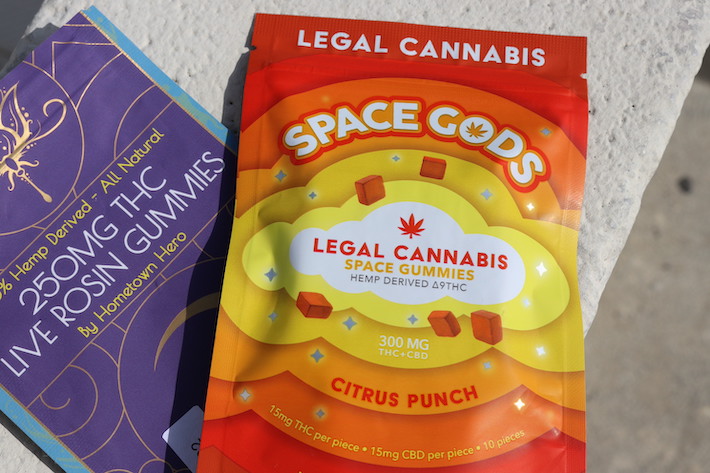
Hemp delta-9 is delta-9 THC, functionally identical to the THC found in ordinary cannabis, except with a proviso that the finished product must be less than 0.3% delta-9 THC by dry weight. This is to keep it “compliant” (more on this later) with the 2018 Farm Bill, which legalized hemp at the federal level. While we can’t think about laws in terms of the nebulous “intent” hiding behind the words, it is clear that the 0.3% by dry weight limit was intended to distinguish intoxicating products from non-intoxicating ones.
The Legal Loophole on Hemp Delta-9
But since you can’t read this intent in the letter of the law, the 0.3% by dry weight limit stands as a hard cut-off between legal and illegal. This is where hemp delta-9 comes in. Imagine you have a product that has a dry weight of 10 g: the law says it can have 10 × 0.3% = 0.03 g of delta-9 THC, i.e. 30 mg. The maximum legal serving for cannabis edibles in adult use states is either 5 mg or 10 mg, so our hypothetical hemp product is three to six times higher than would ordinarily be allowed for an edible. In fact, Gold & Silver’s Delta-9 Gummies advertise 40 mg per serving, four or eight times the limit for legal states. This general issue is the source of much of the controversy around hemp delta-9.
Scientists at the US Hemp Roundtable have stipulated anything over 3 mg of THC violates the intent of Congress via Hemp’s 2018 Farm Bill: “We call on FDA and state regulators to enforce existing laws… cracking down on intoxicating products marketed as hemp that threaten public health and safety.”
Of course, this isn’t really hypothetical: these products really exist. Due to the limitations on the fraction of the finished product which can be THC, hemp delta-9 products tend to be edibles like gummies. They’re generally marketed as “hemp delta-9,” “CBD + THC,” “Full Spectrum” or “Compliant delta-9,” and are available online and in retail stores in all 50 states.
The Analysis: What We Did
We Sampled 40% of Brands on the Market
For the lab study and further market analysis, we purchased 53 of the most popular products online from 48 different brands. We used search volumes to identify the “most popular” products, alongside online recommendations. The 48 brands covered represent around 40% of the total hemp delta-9 market, based on the above estimate.
We ordered a variety of products, but owing to the nature of the market the majority of them were edibles. The products included gummies, tinctures, vape pens, cookies, brownies, chocolate, candies, lollipops, beverages and rice krispies. The vast majority sold some form of edibles (especially gummies), but we identified a few companies offering tinctures and one that offers a vape pen.
The manufacturers included cover a wide range of states to keep the sample balanced. The states included were AZ, CA, CO, FL, GA, IN, MA, MI, MN, MO, NC, NJ, NV, NY, OR, TN, TX, and WI. We made all orders online, after attempting to purchase products from CBD and vape retail stores, but finding that none of the 20-plus stores we contacted carry hemp delta-9 products.
Lab Analysis
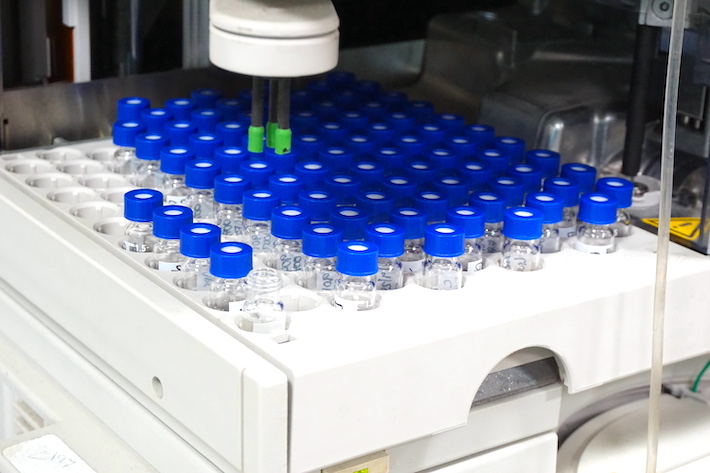
The lab analysis was performed by InfiniteCAL. We sent the products in their original sealed packaging, to minimize any potential degradation and ensure that there was no tampering prior to the testing. All of the products were tested within two weeks of purchase to avoid degradation or other issues. You can read more details about their testing methodology here. The full selection of 53 lab results is available here and has been collected into a spreadsheet (available upon request). The PDF version of the report is available here.
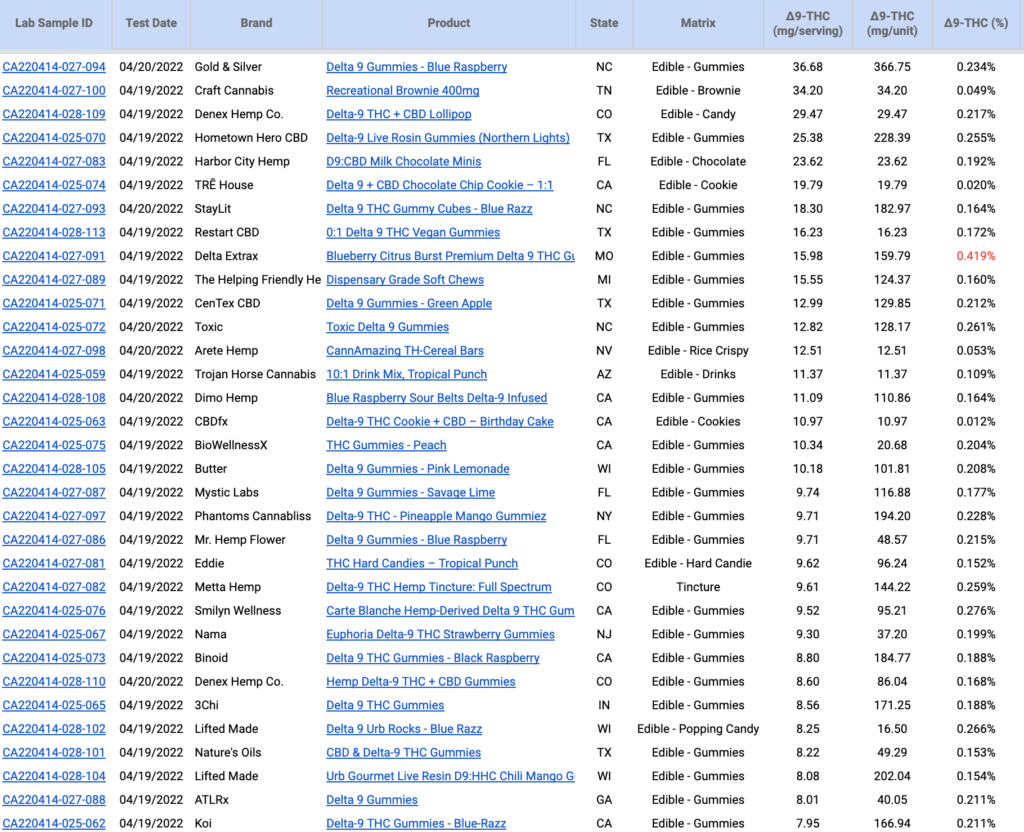
Why We Did It
You might be wondering what drove us, a pro-hemp and pro-cannabis organization, to do something like this. We should be clear that our position on this is just to ensure the law is followed, as well as that ‘we as an industry’ remain ethical. Safety, certifications and purity are essential to our transparency, if we’re to reach new consumers in a relatively new industry. Hemp, cannabis and CBD’s growth (and further legality across the U.S.) depends upon how well we can maintain standards. Legal high THC products could be great for some, where it makes sense and is by adult-consent, but potentially detrimental to minors and those with certain mental health conditions.
Simply put, we believe that companies should give customers what they paid for, and that customers should have re-assurance that this will happen, through high product standards and pre-existing lab results.
The Results: What We Learned About Hemp Delta-9
Estimated Market Size
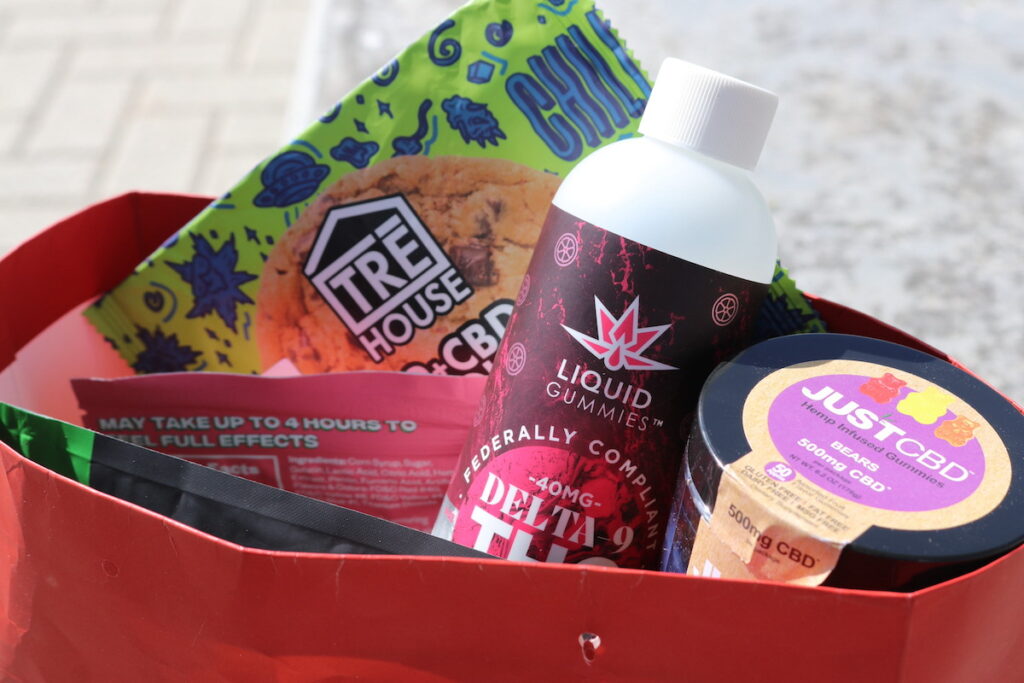
We identified 89 brands currently selling hemp delta-9 products online, ranging from well-known brands such as CBDfx and Hometown Hero CBD through to lesser-known options like Cycling Frog and MoonWlkr. We estimate that this represents around 75% of the total hemp delta-9 market, which translates to 120 brands selling hemp delta-9 as of April.
On average, each brand offers an estimated 15 SKUs (i.e. unique hemp delta-9 products), which equals around 1,800 total hemp delta-9 product SKUs on the market today.
Hemp Delta-9 Products Can Far Exceed the Potency of Cannabis Products
One of the key issues in this discussion is the potency of the hemp delta-9 products. The idea that you can get a potency to rival edibles in states with legal adult use while still complying with the Farm Bill is the basis for this part of the industry.
The potencies of the products we ordered ranged from 0.5 mg to 40 mg per serving. While 10 mg/serving was the most common, which is in line with the limit of 10 mg/serving for edibles sold in dispensaries in California and Colorado, for instance. The highest serving of 40 mg is undeniably very high, and wouldn’t be allowed as a single serving under adult use cannabis laws anywhere in the country.
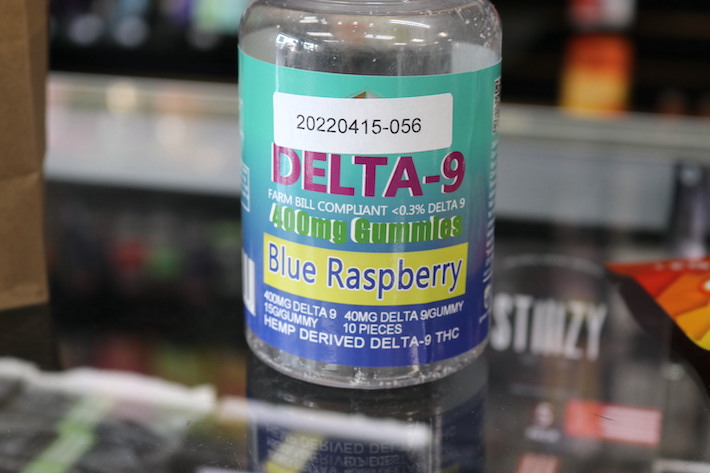
In fact, 34% of products (18/53) exceeded the 10 mg/serving limit. This brought the overall average for the sample up to 13 mg/serving, so the “average” hemp delta-9 product would be illegal under most adult use laws.
The Majority of Hemp Delta-9 Companies Offer COAs
We looked for Certificates of Analysis (COAs) for all of the products we purchased. These are very important because they essentially represent the only way the customer can verify what’s actually in the product that they’re buying. If it says you’re getting 10 mg of delta-9 THC, is that accurate? Additionally, companies can test for substances like pesticides or residual solvents to offer some proof that their product is safe.
The majority (85%) of the products we sampled had a COA available online. This is a great point for the industry, and shows that companies do care about customers’ concerns, as well as wanting to prove their product does what it says. However, there were no COAs for the remaining 15% (8 products total). This isn’t legally required of hemp products, but industry associations and customers push for it.
75% of Hemp Delta-9 Products Are Not Tested for Impurities
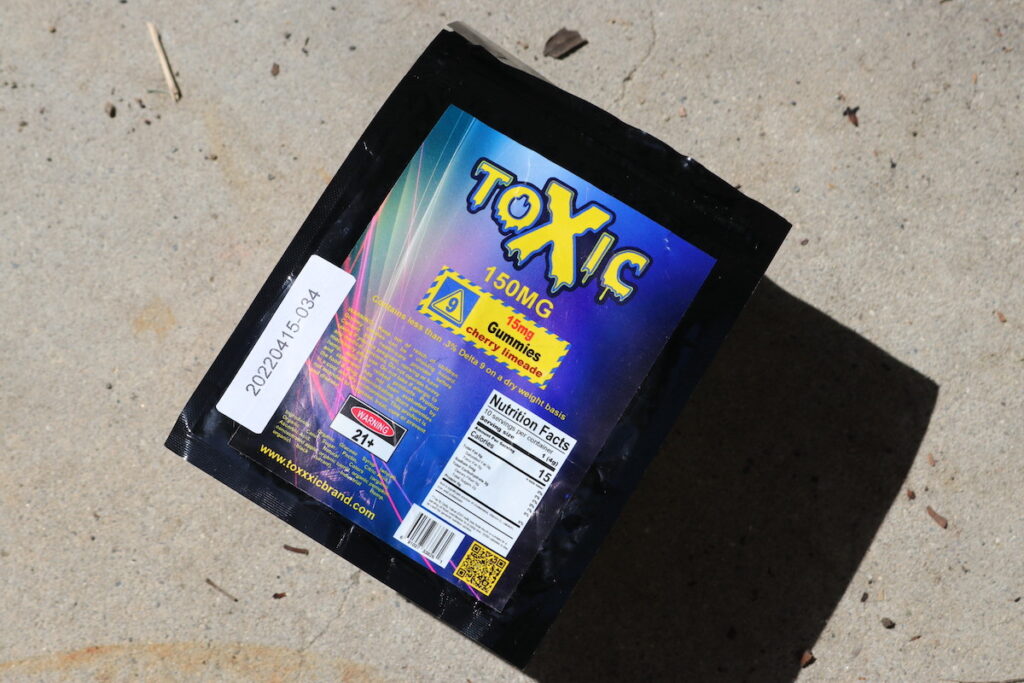
The expectation that companies provide lab results has led most of them to conduct testing for cannabinoid potency. Customers will then know whether they’re getting the amounts of whatever cannabinoid they paid for, and companies can show they’re complying with the Farm Bill. However, this is only part of the story, and many consumers are concerned with things like pesticides, metals and other impurities that might find their way into their hemp product.
Our analysis found that 75% (40/53) of products weren’t tested for such impurities. Since eight companies don’t have COAs at all, this means that around 89% of available COAs don’t cover impurities.
Most Companies Use ISO Accredited Labs
With the rise in demand for hemp products, alongside the expectation of a COA for each product, there has been a corresponding rise in the number of labs offering testing services. However, not all labs (and therefore not all COAs) are equal. Labs should ideally be ISO/IEC 17025:2017 certified. This sets out standards for impartiality, competence and consistency for labs, and is generally used by regulatory authorities and other organizations looking to verify that a lab is reliable.
We spoke to Erik Paulson, PhD, from InfiniteCAL Labs, who emphasized the importance of accreditation, and warned that:
“There are labs in operation, however, that do not maintain any of these certifications or accreditations. While they are not permitted to run compliance samples for the legal cannabis market, they will still perform the unofficial quality assurance tests that have become the norm for the unregulated hemp industry. Unfortunately, without the independent audits that are part of the process to become certified, many of these labs may not generate results that can be considered trustworthy.”
Before adding, “It is incumbent on the hemp manufacturers to choose a reliable lab if they want to make sure that their products are safe.”
Our analysis showed that of the 45 products that had a COA, 9 (20%) conducted testing through labs that were not ISO accredited. The accreditation certificates were verified through the PJLA, A2LA and ILAC databases.
Half of Companies Use DEA Certified Labs
The USDA’s database can also be used to verify which labs are DEA certified. This is important because the DEA is one of the major organizations responsible for enforcement, so using a certified lab gives companies some extra confidence that their products are legal. However, we found that 49% of the products with COAs used labs that were not DEA certified.
Fewer Than Half of Products Have a Batch Label
We also looked at the availability of batch numbers for the products included in the analysis. We found that 51% (27/53) didn’t include a batch ID on the packaging. This is another important issue for quality assurance and safety: if there is a problem, companies should be able to trace it to a specific batch to enable suppliers (and customers) to dispose of potentially harmful products.
Warning Labels, Mostly a Win
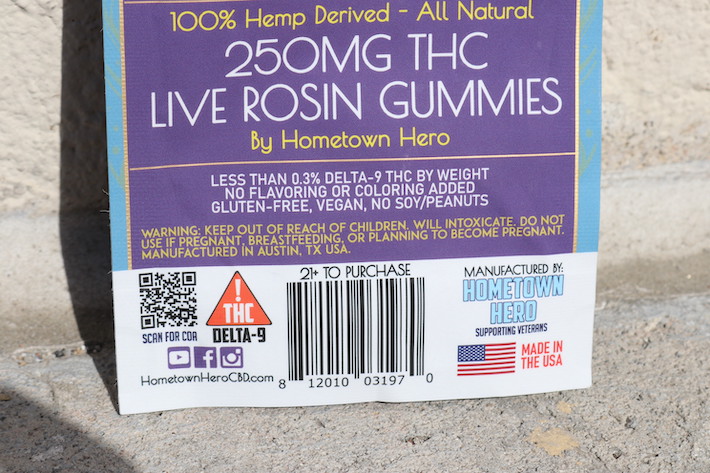
The analysis also showed that 17% (9/53) of products didn’t include warning labels. However, the majority of products included warnings such as:
- For adults 18+, or 21+ where state law applies
- Will intoxicate, use extreme caution
- Keep away from children or pets
- Don’t drive after using
- Don’t operate heavy machinery
- Don’t consume if pregnant or breastfeeding
- Don’t consume if you are subject to drug testing
- Consult with your physician before use
This is likely to be known by most customers, but since hemp delta-9 is a hemp product and is sold legally, some customers may be unaware and assume it is non-intoxicating.
Most Products Don’t Have the Cannabis Universal Symbol
We found that 74% (39/53) of products don’t include the cannabis universal symbol (or some variation) on their packaging. This is a requirement in legal states to make it clear to customers that it contains large amounts of THC.
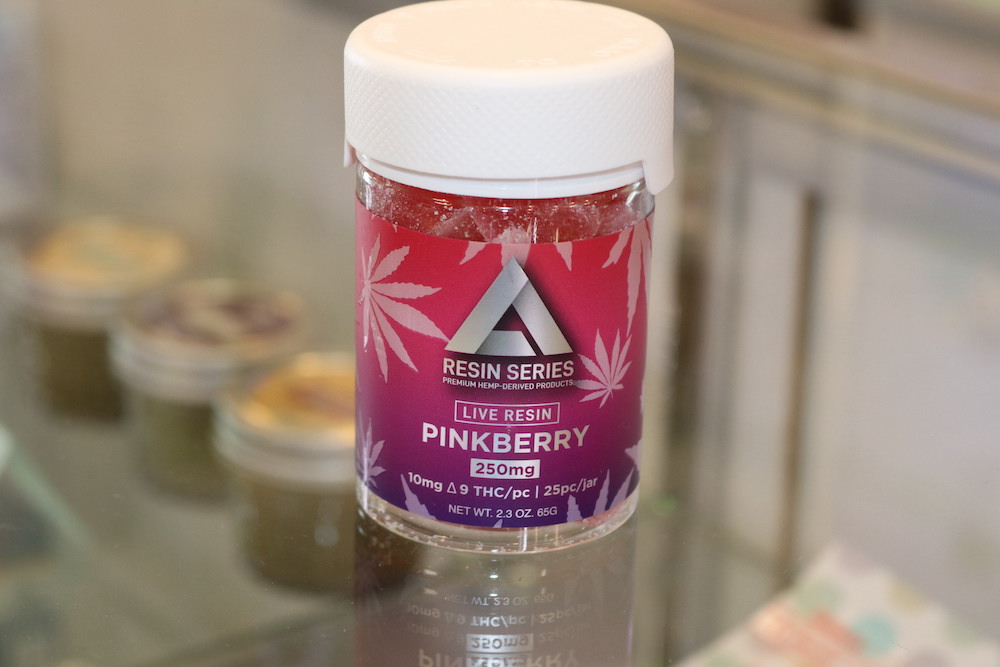
This wouldn’t be necessary on traditional hemp products, where the amount of THC per serving is so small that it’s unlikely to have any effect. Hemp delta-9 products are different, but because of the assumption that hemp isn’t intoxicating, if anything this symbol is more important to include in this case.
Very Few Companies Use Child Resistant Containers
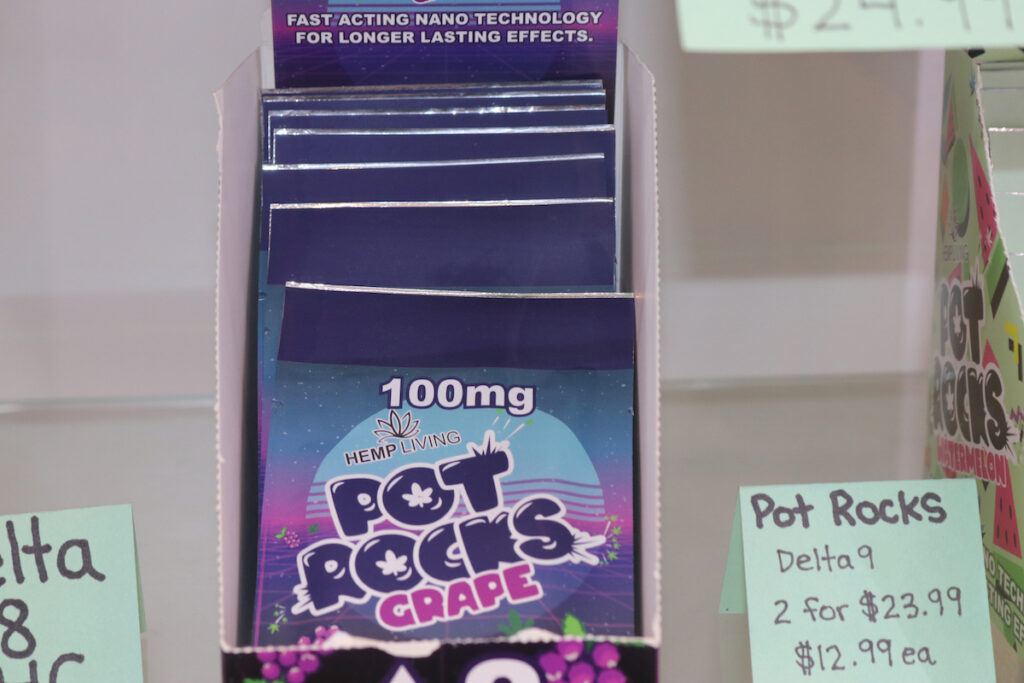
Based on our analysis, 81% (43/53) of hemp delta-9 products don’t use a child-resistant container. Most parents would know not to keep any hemp product around where kids can get access to them, but a child-resistant container is a good last line of defense.
Checkout Age Verification is Rare
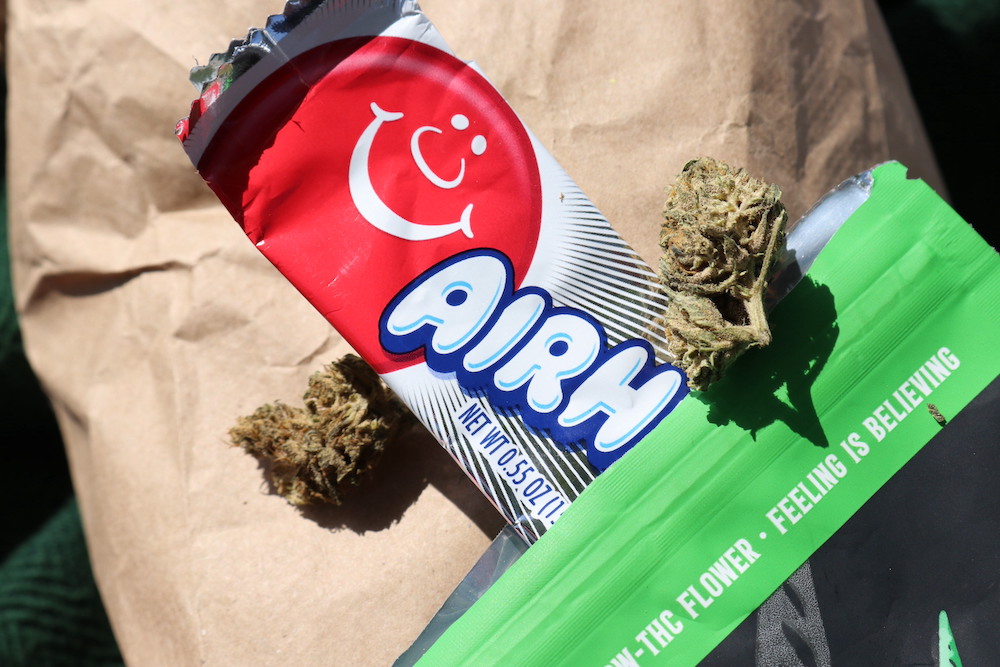
Only 15% of products purchased (8/53) had any online age verification at checkout. All of the ones who included age verification used AgeChecker, which basically cross-references the submitted information with public records to verify who the customer is, or if this fails, asks for a picture of some ID. This isn’t infallible, but it’s much better than for the 85% of companies who did nothing.
Only One Product Required an Adult Signature on Delivery
It’s entirely possible for a teenager to get hold of a credit or debit card and place an order for some hemp delta-9, provided any checkout age verification is lax or non-existent (as it seems to be). But in an ideal situation, companies would ensure the product was delivered to a legal customer by requesting an adult signature on delivery. Unfortunately, all but one product (98%, i.e. 52/53) was just dropped into the mailbox with no signature requirement.
This means a youth could purchase a hemp delta-9 product, in their own name, and have it dropped off at the mailbox, with nobody actually checking their age at any stage in the process.
Lab Results
We had three major goals for the lab analysis: to check that products were indeed under 0.3% delta-9 THC by dry weight, to check that the stated potency is accurate (so a customer would know roughly what to expect) and to see if contaminants or other impurities are an issue in the industry.
Almost All Products Fall Within the 0.3% Delta-9 THC Limit
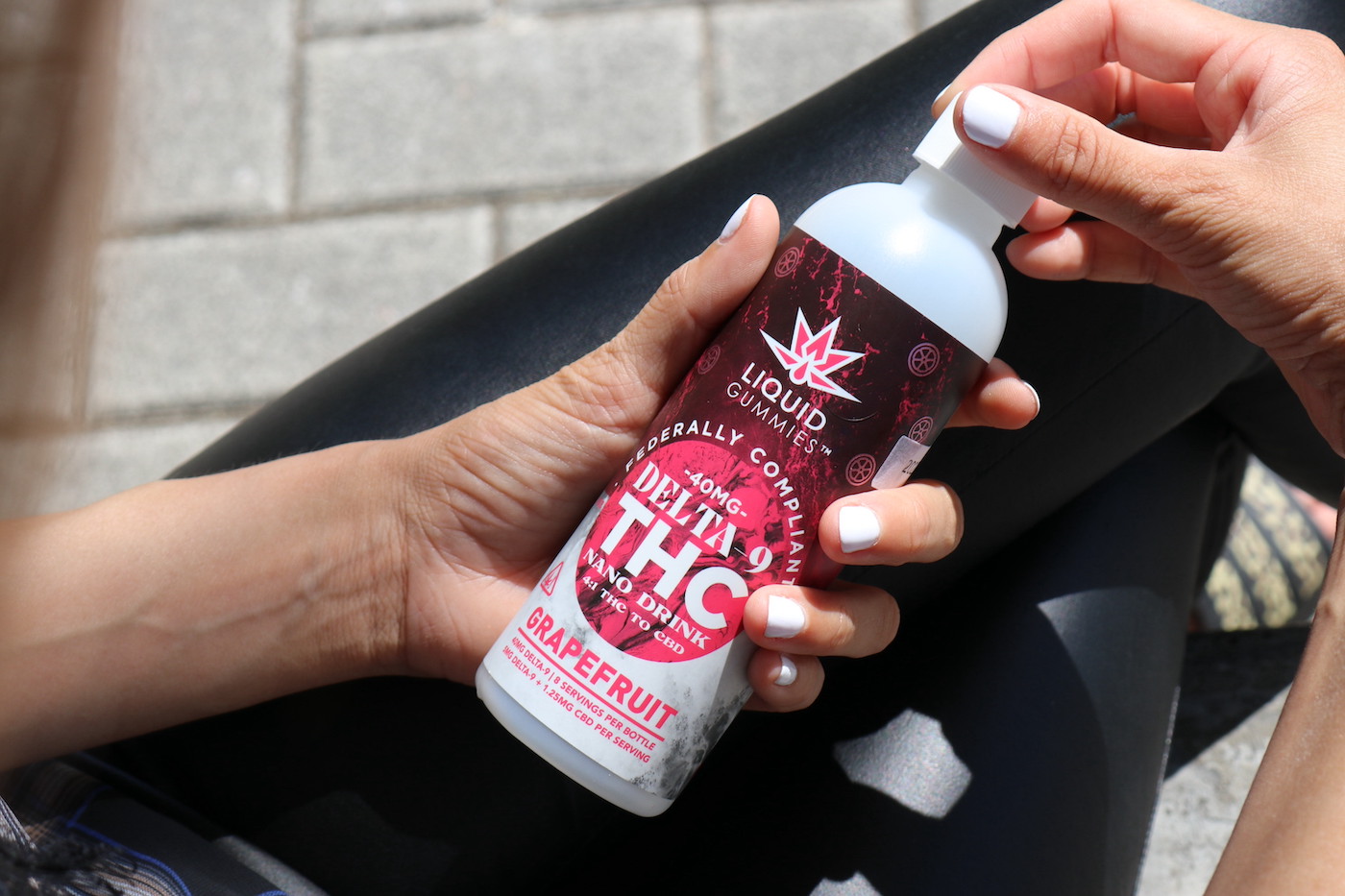
The lab analysis performed by InfiniteCAL confirmed that all except two of the products (96%) fell within the 0.3% THC legal limit. This might seem like the minimum you’d expect, but from our similar analysis of delta-8 products, it’s clear that this is far from a given. In fact, the lowest results (with delta-9 at detectable levels – more on this in a moment) were 0.009% delta-9, and the highest was 0.419%, so even the violations were really quite small.
So, based on our analysis, we can assume that the vast majority of products do indeed fall within the THC concentration specified in the Farm Bill. Under that legislation alone (and the most conventional reading), they would be considered legal.
45% of Products Gave Smaller Dosages Than Advertised
Although legality is an important issue, arguably more important from a consumer perspective is whether or not the doses are in line with what’s advertised. On this front, the results aren’t too great for the hemp delta-9 companies. The total amounts per product ranged from 0% of the advertised amount to 60% more than the advertised amount.
If we consider anything within 15% of the advertised dosage to be “accurate” (so for a 100 mg product, anything from 85 to 115 mg), only 49% of products (26/53) were accurately labeled. In other words, you have worse odds than a coin flip of getting what you paid for. Of the mislabeled ones, the vast majority (24/27, i.e. 89%) gave customers a smaller dose than they expected.
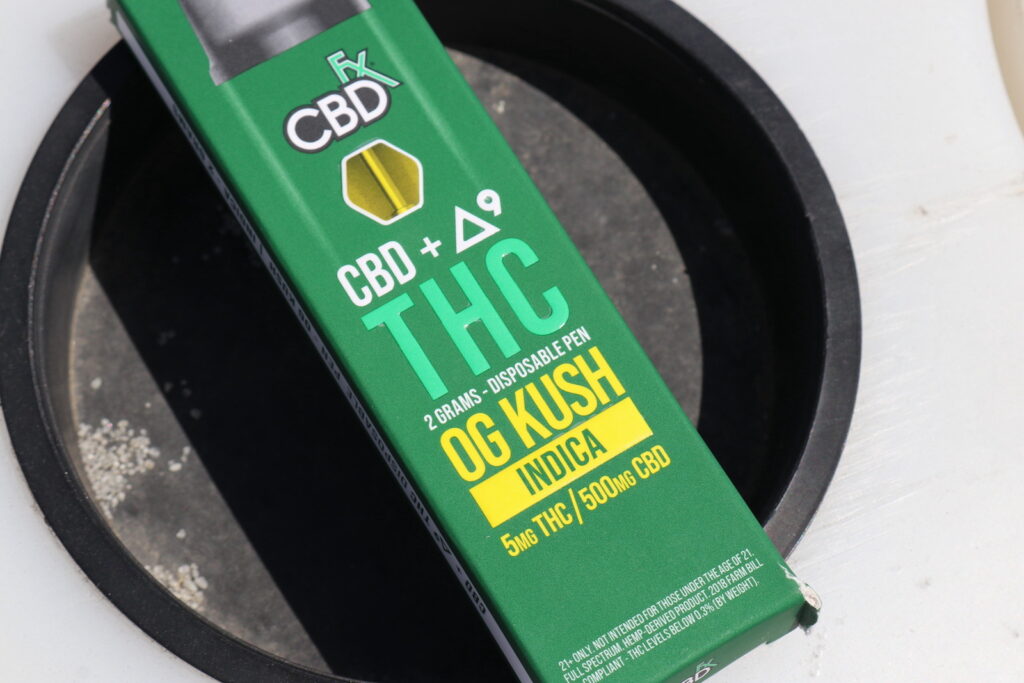
Some of the results are interesting to look at. First off, a disposable vape pen from CBDfx contained no detectable delta-9, despite advertising 5 mg per unit. This is an extreme case (and the other CBDfx product – an edible – came out at 110% of advertised), but the Vegan Strawberry Hemp Gummies from Kandy Girl advertised 10 mg per serving but only delivered 0.45 mg per serving, coming out to 4.5% of the claimed amount. On the other end of the scale, the gummies from Delta Extrax claimed 100 mg of delta-9 per unit but actually contained 160 mg, 60% more than the claimed amount.
Most Products Converted CBD into THC to Reach Their High Levels
One problem for hemp producers is that the plants bred for hemp just don’t have much THC to start with. It’s possible to just use the hemp for the delta-9, but many producers take a shortcut, either by using THC from cannabis and adding it to the product, or by converting CBD into delta-9 using a similar isomerization process to the one used for delta-8 THC.
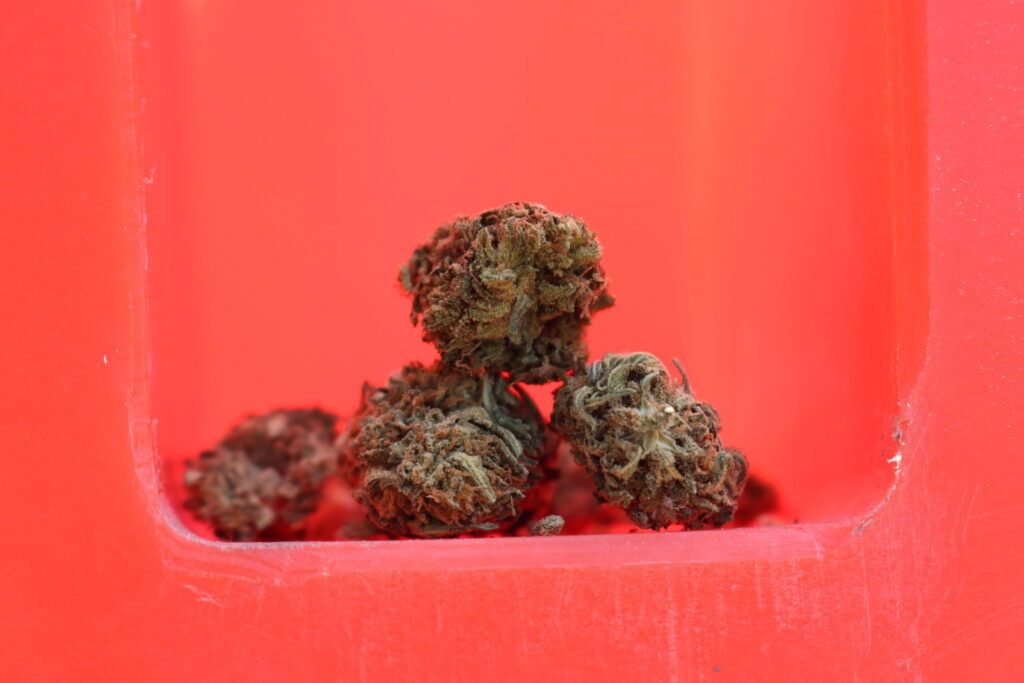
However, the signature of this is visible in the lab results, according to Dr. Paulson from InfiniteCAL, and he confirmed the breakdown to us by email:
“Even though hemp and cannabis are part of the same species (Cannabis sativa L.), there are certain differences in some of the compounds that are developed during their growth process, aside from the delta-9 THC concentration. There are some compounds that are only present in hemp, and others that are only seen in cannabis. In addition, unique compounds are formed as side products during the conversion from CBD to THC. The compounds for each grouping give us markers that allow us to assign the origin of the delta-9 THC source used in the manufacturing process with reasonable confidence.”
His analysis shows that 64% (34 products) used the isomerization process from CBD to produce the delta-9. Another 19% (10 products) used THC from cannabis to beef up their levels, and finally, just 17% (9 products) used natural hemp-derived THC.
The high proportion of products using converted THC is a potential problem because it raises legal questions surrounding synthetic THC. This basically comes down to the fact that synthetic THC is listed as a Schedule I Controlled Substance. Whether delta-9, identical to that found in the plant, classes as “synthetic” is a legal discussion that could really go either way.
Safety Testing: Hemp Delta-9 Products Are Free From Contaminants
We also commissioned testing for contaminants on ten of the products, and the results for this are also very good news for customers and the industry. All of the tested products were found to be free from solvents, pesticides, metals, mycotoxins, microbials and foreign matter. Although companies don’t commission such testing on their own products as often as they should, this strongly suggests that it isn’t a substantial issue.
It’s worth noting that we found the same thing when we tested hemp delta-8 products, thus implying that hemp companies in general are pretty good at avoiding contamination.
However, we did also speak to Dr. Paulson from InfiniteCAL and Ryan Bellone from KCA Labs, who both confirmed that they’d had products fail on these tests in the past. Ryan Bellone pointed to solvents in particular, such as ethanol from flavorings. Dr. Paulson said he’d seen products fail for all of the above reasons, and also pointed out a potential issue with companies that raise the THC levels by chemically converting CBD:
“As it is clear to us that ‘hemp-derived delta-9’ products can be manufactured using different sources of THC, the types of potential safety issues are going to be different depending on the source. If the source is natural cannabis or hemp, then safety will be largely focused on the same types of impurities that are found in cannabis and hemp: pesticides, mycotoxins, residual solvents, heavy metals. If the source of delta-9 THC is via conversion from CBD, the concerns may include the above contaminants, as well as other residual chemicals that are left over from the conversion.”
This means that all possible contaminants are unlikely to be covered by the standard selection of tests, unless it’s a natural hemp product.
Stephen Goldman, chief science officer and lab director at Kaycha Labs, Colorado, also emphasized the difficulty of detecting all impurities and the importance of safety testing, “Many of the hemp THC isomers have side reactions which show impurities exist at high levels. The catalysts and chemical reagents used to perform these chemical reactions can also contribute safety concerns not addressed without full risk assessments and contaminant testing profiles.“
Discussion: What Do The Results Mean? And What Should We Do About It?
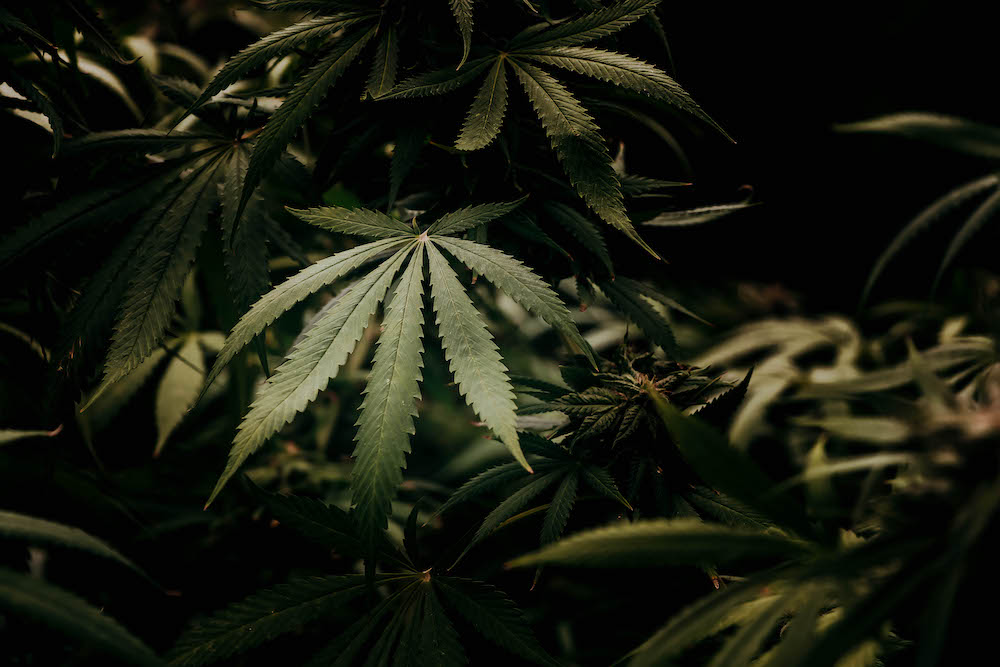
All Products Were Under 0.3% Delta-9, But Are They Legal? Two Perspectives
The legality of hemp delta-9 is the central issue in this whole debate. While the 2018 Farm Bill seems to support its legality, this opinion isn’t shared by everyone, with some claiming that the bill is being misused. Others point to existing FDA rules around approved drugs in food products as a reason most hemp delta-9 (and even potentially CBD) products are actually illegal. But if that is true, how are the companies still selling it? We’ve outlined both positions here.
Pro: Hemp Delta-9 is Legal
We spoke to Neil Willner from RCCB Law, who outlined the position that hemp delta-9 is legal very nicely:
“While I don’t think it was the intent of the authors of the 2018 Farm Bill to create a pathway for unregulated intoxicating cannabinoid products, the “spirit” of the law is not relevant when the text of the law is crystal clear which is the case when looking at the 2018 Farm Bill. The definition of hemp is unambiguous and broad; ‘the plant cannabis sativa l. and any part of the plant, including the seeds thereof and all derivatives, extracts, cannabinoids, isomers, acids, salts and salts of isomers, whether growing or not, with a delta-9 tetrahydrocannabinol concentration of not more than 0.3% on a dry weight basis.’
Delta-9 THC in hemp is therefore not a controlled substance so long as it exists in concentrations no greater than 0.3% on a dry weight basis. In an often overlooked May 28, 2019 memo from the USDA’s General Counsel, Stephen Vaden seemingly goes out of his way to explain that the 2018 Farm Bill removed delta-9 THC in hemp from the Controlled Substances Act. This is one of many indications that the plain text of the 2018 Farm Bill is clear.”
He acknowledges that the FDA could technically attempt to enforce the existing ban on adding THC (or CBD) to food, as per the Food Drug and Cosmetic Act (FDCA). However, this has been possible for CBD for several years, and yet they haven’t enforced this rule.
So in the absence of this, it’s clear that delta-9 THC is legal provided it is derived from hemp and falls under the 0.3% by dry weight limit.
Con: Hemp Delta-9 is Illegal
Shawn Hauser from Vicente Sederberg is one of the most prominent voices claiming that intoxicating hemp, such as hemp delta-9, violates the spirit of the Farm Bill and that state or FDA regulations may render them illegal. She isn’t against cannabis itself – in fact is pro legalization – but believes that the Farm Bill is being misinterpreted, or at least misused, in the case of intoxicating hemp products such as hemp delta-9:
“The intent of the 2018 Farm Bill was to legalize hemp, including industrial hemp and hemp ingredients that have safety profiles appropriate for ingredients in food, dietary supplements, cosmetics, and other consumer products. It’s clear that the intent of the 2018 Farm Bill was not to legalize intoxicating products, and FDA authority was expressly preserved to ensure consumer products containing hemp met applicable safety profiles. Hemp derived delta 9 products and other intoxicating hemp products were not the types of products intended in passing the farm bill and violate the spirit and intent. However, CBD, CBN, CBG, and other cannabinoids appear to have safety profiles consistent with the type of non-intoxicating hemp ingredients envisioned by the Farm Bill.”
This “intent” argument does appear to be legitimate, as Russell Coleman, ethics counsel to the U.S. Hemp Roundtable and ex-senate staffer, argued in their statement on intoxicating hemp:
“As a Senate staffer who was deeply involved in drafting initial U.S. hemp laws, I can attest that hemp’s legalization was only made possible by assembling a broad coalition based on the foundation of hemp being a non-intoxicating agricultural opportunity. “Rope not dope” was the motto of proponents of renewing an industry with such deep historical roots. Companies and organizations that seek to profit by misusing the hemp name to market intoxicating products threaten to destroy that coalition.”
Hauser also argues in Hemp Grower that companies are looking entirely at the 0.3% limit on delta-9 on a dry weight basis and using this to determine whether or not their products are legal. “And the inherent flaw with that [interpretation] is that [the 2018 Farm Bill] said, ‘a dry-weight basis.’ That, by nature, doesn’t account for moisture and the weight of the gummy material, or whatever is in the oil.”
She also echoed a point made by Neil Willner, Rod Kight and others about the Food, Drug and Cosmetic Act (FDCA), adding “Hemp derived delta-9 products are illegal under FDCA, many state laws, and potentially under the Controlled Substances Act depending on how they are manufactured.”
Willner explains a little more that, “Throughout its guidance documents and warning letters on CBD in foods and beverages, the FDA was careful to always include THC in its analysis as well. Just like with CBD, the FDA takes the position that THC is an impermissible food additive and that THC products cannot be sold as dietary supplements. In an overly simplified explanation, this is because THC is an active ingredient in a drug product that has been approved by the FDA (Marinol and Syndros); just like CBD is an active ingredient in the FDA-approved drug, Epidiolex.”
What Does the 0.3% Limit Really Mean?
The limitation of “not more than 0.3% delta-9 THC by dry weight” in the Farm Bill is the most crucial detail in the law, so it’s important to understand what exactly it means.
Shawn Hauser states her view clearly: “The dry weight basis is applied to the plant material, and FDA authority to regulate finished products within its jurisdiction was expressly preserved.” In other words, the Farm Bill applies to the hemp plant material and all other products are the FDA’s business.
Dr. Paulson went into more detail about the intent of the phrase dry weight: “The “dry weight basis” terminology of the 2018 Farm Bill is intended to take into consideration the moisture content of hemp flower or biomass when determining the THC content of that flower. Therefore, for every cannabis and hemp flower sample that is received, a moisture analysis is performed to determine the moisture content and provide a moisture correction factor. When it comes to infused hemp products, it is not standard practice to perform a moisture analysis unless requested by the customer.”
Adding that, “Without clear regulatory guidelines on how to treat products made from industrial hemp, this standard practice will not change. The Colorado guidelines mentioned above, which are the most comprehensive state guidelines to date for industrial hemp products, do not state a requirement for a dry-weight correction for finished products, and only require it on the biomass.”
The 0.3% dry weight limit is essentially all companies have to work with. Both Hauser and Paulson argue that this was intended to refer to on-farm biomass, but there is no clear guidance from the FDA, so the interpretation is a little vague. Rod Kight is dismissive of the on-farm biomass argument in his blog post:
“The Farm Bill’s definition of hemp does not make any reference to “on-farm biomass”. It simply defines hemp and removes it and the THC in it from the CSA. Moreover, as I referenced above, both the Congressional Research Service and the DEA agree that the 2018 Farm Bill legalized hemp products, not just the plant. Additionally, if we take this argument at face value and assume that the definition of hemp only applies to on-farm biomass and not to finished products, then all full spectrum CBD products containing up to 0.3% THC currently on the market and which have been marketed for several years are illegal. This is clearly not the case. Not even DEA takes this position.”
So the meaning of the limit is, unfortunately, unclear. While it referring to on-farm biomass does make sense, the Farm Bill definition of hemp includes “the seeds thereof and all derivatives, extracts, cannabinoids, isomers, acids, salts, and salts of isomers, whether growing or not,” in its definition of hemp. In other words, the bill considers an extract from hemp to also be hemp, providing it’s within the dry weight limit. So on-farm biomass wasn’t the only consideration.
Because of this, Neil Willner and many others think the current approach is correct, “The industry has applied the delta-9 limit to both the original plant and a finished preparation and while I think that’s the correct interpretation, it has not been tested in court.”
Are Hemp Delta-9 Products Labeled Accurately Enough?
Probably the most shocking result from our lab analysis is that a surprising amount of products don’t contain a similar amount of delta-9 to what was advertised. This raises serious issues for consumers, because a 30 mg dose is a very different thing from a 15 mg dose. On the other side, while not as potentially concerning, getting half or less than the dose you wanted is kind of useless and customers will feel cheated out of their money.
The lab results show that over half of hemp delta-9 products differ from the advertised dosage by more than 15%. In other words, whether you’ll get the amount of delta-9 you were promised is a little worse than a coin flip. It’s skewed towards lower amounts than advertised, but there is a chance that you get up to 60% more THC than you were expecting (taking the worst example). This was a product from Delta Extrax which contained 160 mg of THC in total, but only advertised 100 mg.
It’s more likely you’ll get a low dose, and there are many examples of this in the data. The most extreme is the vape pen mentioned before which contained no THC, followed by another gummy from Kandy Girl which had just 0.45 mg per serving. Beyond this, TRĒ House’s Delta-9 Gummies with CBD are a less extreme example: they contained less than a fifth of the THC customers were promised, a total of 37.8 mg based on testing, compared to 200 mg advertised.
While there is room for debate on how dangerous this is or could be, it’s undeniable from a consumer perspective that this level of variation is unacceptable. If you’ve ever tried edibles and made the classic mistake of eating another because the first one “didn’t work,” you know how overwhelming and possibly unpleasant getting too high a dose can be.
Are Companies Doing Enough to Stop Minors Purchasing Hemp Delta-9?
Another crucial issue for the hemp delta-9 industry is how easily under-18s can get hold of hemp delta-9 products. Chris Lindsey, vice president of policy at the US Cannabis Council, commented to us that: “We can imagine that minors access these products – as you indicated sometimes they are not subject to age requirements. Unfortunately we can’t know just how often simply because in many parts of the country, there is no oversight.”
Similarly, Gillian L. Schauer, PhD, MPH from the Cannabis Regulators Association (CANNRA), pointed out to us, “They are readily available to youth because they are widely sold online and in grocery stores, gas stations, convenience stores, and other locations that are easily accessible to youth. Even in cases where states have taken legislative action to try to limit youth access to high-THC hemp-derived products, there has been little to no federal action to regulate the interstate commerce for these high-THC hemp-derived products, including sales that continue online with no real age verification.”
Of the 53 products we purchased for this lab study, only one required a signature at the door on delivery, with the vast majority just being left in the mailbox. This makes it incredibly easy for minors to get hold of hemp delta-9 products. This could have been managed through an online age verification platform during checkout, but this only happened for 15% of the products.
High THC Disproportionately Affects Young People & Mental Health
Clearly there is more that can be done to prevent minors getting access to hemp delta-9. While some people might not be concerned about CBD, for example, there are stronger arguments in favor of limiting youth access to THC. For example, the evidence shows an increase in risk for psychotic conditions like schizophrenia for teens that use marijuana, and there are strong suggestions that it leads to problems with neurocognitive performance, and alterations in brain functioning and development.
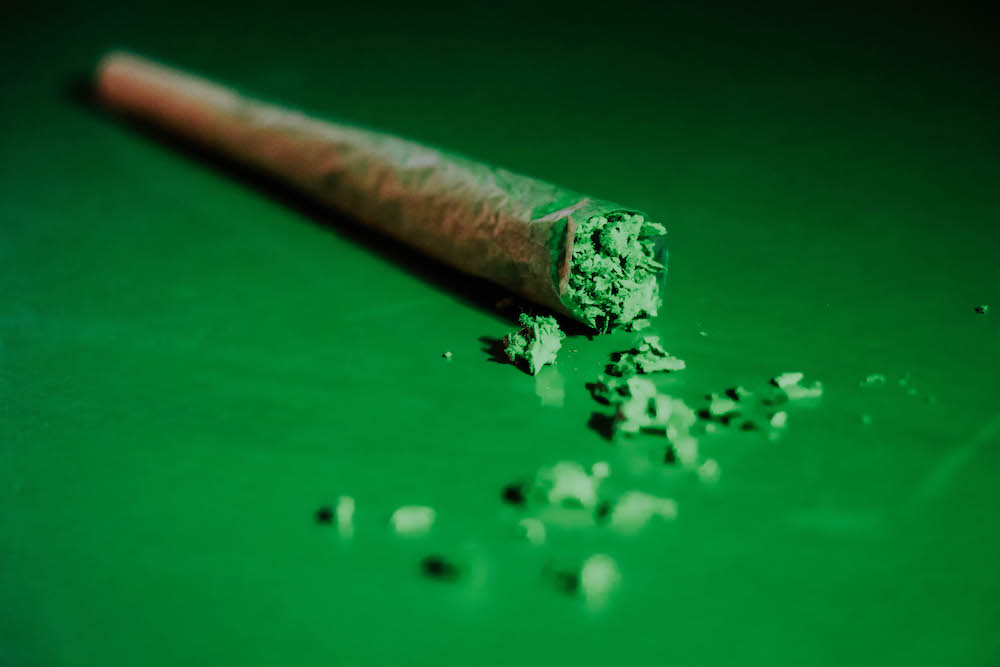
Many studies have shown that the risks of cannabis (really, anything high in THC) are even greater for youth, particularly when it comes to schizophrenia and psychosis. As well as more severe impacts like this, research has also shown that cannabis use as a teen is linked to depression and anxiety in young adults. Health information programs from state governments (such as this from California) also point out the impact on learning, memory and attention, noting that teens who use cannabis are more likely to skip classes, get lower grades and drop out of school compared to those who don’t. While this certainly isn’t a definite, it’s also clearly true that the effects of cannabis can filter through into your educational and professional life.
This is why legal adult use states still insist on the adult part. In fact, a big benefit of legalization is that a legitimate supply is actually possible to age-gate, unlike the black market. Rather than opening up young people to these risks, legalization allows states to provide up-front information to consumers and institute strict age verification policies in dispensaries.
It’s important to remember that the possible defense that it’s “just hemp,” doesn’t really apply here. The hemp products in question can have more THC than edibles in adult-only dispensaries. Legally, it’s hemp, but practically it’s marijuana. Part of the responsibility – not legal responsibility, but moral – of selling high-THC products is making sure it stays out of the hands of minors.
Are Hemp Delta-9 Companies Doing Enough Quality Control?
The finding that the labeling is often wrong for hemp delta-9 products invites questions about quality control in the industry, and whether they’re doing enough. Unfortunately, the results of the lab study suggest that quality control isn’t really what it should be. This is a known issue, as Paul Armentano, deputy director of NORML commented to us:
“NORML has consistently reported on findings that these unregulated products are frequently mislabeled for potency, often contain variable purity, and that they may also contain heavy metals and other unwanted constituents (e.g. synthetic cannabinoids) that may pose a risk to consumer’s health and safety.”
It’s difficult to point to an exact reason for the discrepancies between the advertised and measured amounts of delta-9 in hemp products, but regardless, it’s a sign of lax quality control. Some variation is expected from extractions from different plants, and depending on the efficiency of the extraction process too. However, with consistent standards and processes, this can be kept to relatively small levels.
Most importantly, COAs give the companies a chance to check that their products are described accurately. The problem with this is that if you test a batch of your delta-9 gummies in December, will the April batch be the same? It certainly could (and should) be, but the only way to check is by doing regular lab tests, ideally on each batch. Additionally, if you leave a hemp delta-9 product in storage for a long period of time, there will be changes in its composition over time. Dr. Paulson from InfiniteCAL explained the ideal situation for quality assurance testing:
“The stability of various cannabinoids in cannabis products is highly variable. Factors that can influence their stability are product type, storage temperature, light, and moisture. Assuming that all of these factors can be controlled properly, it can be expected that the products should generally maintain their composition for the first 3-6 months. As samples extend past a year, the potency of the cannabinoids should be expected to decrease. As a general rule, companies should test every batch of product they intend to sell and tests should be repeated every 12 months to determine the current compositions of the products.”
The situation doesn’t look great, but the industry should also be praised for generally keeping their products free of contaminants. From the 10 products we additionally tested for safety, we found no evidence whatsoever of contamination. This is a sign that companies, on the whole, source good-quality hemp and take care to avoid obvious safety issues with their products.
So while safety issues appear to be under control, accuracy in dosing seems a little lax. However, this is mainly a symptom of a bigger issue: the double-standard in regulation for hemp-derived and cannabis-derived products, even if they contain a similar amount of THC.
How Are Hemp Delta-9 Products Regulated?
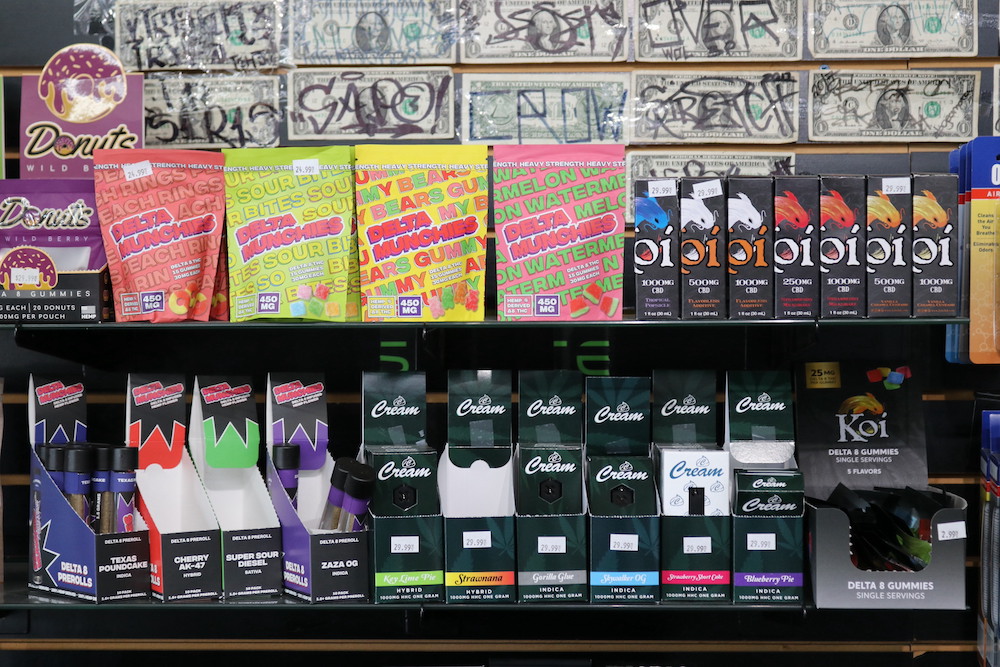
The Farm Bill’s separation of “hemp” from cannabis also filters through into the regulation of hemp products in comparison to cannabis products. Generally speaking, hemp products don’t have the same strict limits that exist for cannabis products. For example, most legal adult use states limit the maximum dose of delta-9 per serving at 10 mg, but for hemp there is no “per serving” limit by default.
The FDA has taken a hands-off approach so far, and states have been stepping up to bring in rules to protect consumers. Product safety requirements are becoming more common, in states such as Kentucky, Colorado and New York in particular, and Alaska (for example) requires testing of each batch of products prior to sale. Other regulations include things like labeling requirements (e.g. full listing of cannabinoids and scannable QR codes leading to certificates of analysis), and limitations on maximum serving sizes for THC and other cannabinoids.
However, despite all of this, it’s important to remember that these regulations are generally much more relaxed than those imposed on legal cannabis companies. Dr. Paulson explained the situation in California. Like in most legal states, there is a Department of Cannabis Control (DCC) that’s in charge of the intoxicating, dispensary-sold cannabis products, and the California Department of Food and Agriculture (CDFA), which are responsible for the hemp.
Dr. Paulson notes, “While there are very strict requirements by the DCC on testing and reporting cannabis samples for official compliance (which is needed to be performed prior to sale of the products in a dispensary), there are no reporting requirements for unofficial QA samples. Conversely, the CDFA only monitors hemp at the time of harvest to ensure it does not contain greater than 0.3% THC. Once the hemp is processed and its extracts infused into products, there currently is no regulatory body in California responsible for the monitoring and enforcement of those products.”
This situation is very common in different states across the country. This two-tier system allows hemp companies to operate with very little scrutiny (beyond ensuring that the crop is complaint at harvest) while cannabis companies have many more hoops to jump through even for a largely identical product. Many people in the industry and outside of it see this as an unacceptable situation.
It should be noted, though, that many hemp companies do impose their own restrictions and standards, as well as ensuring they meet all legal requirements. Matt Muratet from Delta Extrax underlined this point:
“We impose many restrictions to ensure safety and responsibility. To begin, we have a certified age-checker to verify all sales and guarantee that our products are inaccessible to minors. We also stay up-to-date with local and state regulations, so we impose restrictions on certain products going into certain locations. We update these restrictions fairly often and continue to stay informed so that we can properly ensure safety and responsibility of our products.”
Should Hemp Products Be Subject to the Same Rules as Cannabis Products?
The issue of regulation is another one which divides opinion in the cannabis community and more broadly. Should we treat hemp products more like we treat cannabis products? Or should we allow the glut of new, hemp-based businesses to flourish and leave any regulation very light-touch? Does it make any difference if the product makes you intoxicated?
Chris Lindsey from the US Cannabis Council commented to us that:
“Our primary concern [with hemp delta-9] is over the health and safety of consumers, because products that are derived from hemp are often produced and sold without any oversight or regulation. Both the chemicals needed to extract from plant material, and the chemicals created when those are converted into intoxicants can be harmful, and tests have shown just how widespread the problem is. The Centers for Disease Control and Prevention issued a warning that labels cannot be trusted. Our concern is that someone could take such a product and be harmed by it, thinking it is similar to regulated cannabis products safely available through state cannabis licensing programs.”
As mentioned in the previous section, many states are increasing rules around hemp products in the absence of FDA or other federal recommendations. This tends to be easier in legal states such as Colorado which already have regulatory standard for high-THC products that can be easily applied where appropriate. Shannon Grey from the Colorado Marijuana Enforcement Division explained the current system for hemp products in the state:
“More generally, industrial hemp products are permitted to be sold in legal Colorado marijuana businesses or used as an ingredient in marijuana products if they 1) come from a Colorado hemp registrant, 2) meet the definition of “Industrial Hemp Product” and 3) the products go through the same vigorous testing required by marijuana products (outlined in this 2020 compliance tip) including but not limited to potency testing, to ensure the product contains no more than 0.3% delta-9 THC on a dry weight basis. MED’s 2021 industry bulletin also outlines that synthetically derived hemp products are prohibited.”
Many people in the industry and legal experts share this view, advocating bringing standards for products that can get you high into line with existing standards for cannabis products. For example, Shawn Hauser from Vicente Sederberg argues that “intoxicating hemp products that contain high levels of Delta-9 THC should be regulated under state cannabis laws where there are robust manufacturing, safety, testing, packaging, labeling, and other standards.”
There are conflicting opinions, though, and others argue that increasing restrictions could impact the hemp industry and affect more widely-accepted products like CBD tinctures. There are a few arguments for this position, in particular that keeping rules lax makes it easier for research to study hemp and its products, and that it’s invaluable for people living in non-legal states that use cannabinoids medically. Additionally, keeping rules light-touch will make it more feasible for farmers and low-level players in the burgeoning industry to stay afloat.
Nicholas Warrender, CEO of Lifted Made, took a similarly liberal approach, “Today, cannabis is federally criminalized and research into its potential medical value is stifled, while hemp products are widely commercialized with almost no oversight. The rules affecting the hemp industry and THC’s role within it continue to evolve and while much remains uncertain, Lifted Made feels confident that this emerging market is here to stay. I think we’ve learned a critical lesson from Prohibition, being that it doesn’t work and actually helps fuel the growth of a dangerous and illicit market.”
These are the two “extreme” ends of the scale, but there are options that could strike a balance between them. For instance, states could bring in gentler recommendations for hemp products, perhaps requiring COAs including safety testing and limiting the maximum delta-9 allowable per serving and/or per package, but not as strict as you’d expect on a regulated cannabis market.
Jody McGinness, executive director at the Hemp Industries Association, argued for some balance in regulations:
“We stand for the whole hemp plant and any products derived from it, which is why we have called for states to avoid ineffective bans on hemp products – which put consumers at risk by creating black markets – and instead, to create guidelines that are grounded in science and that safeguard consumer health.
It’s an uphill climb. Reality-based regulations can be a challenge when you have a media landscape primed for sensationalism and everyone from moral scolds to paid shills for competing industries fearmongering around these complex issues.”
Nathan A. Lennon, an attorney at Reminger, emphasized that whichever action was chosen, the current system can’t be allowed to continue:
“Federally, it seems fairly clear to me that hemp-derived Delta-9 is a Schedule I controlled substance. With the majority of states moving to legalize cannabis, it probably is incumbent on the federal government to pass legislation to remove Delta-9 from the controlled substances list, at a minimum, and perhaps to provide some sort of uniform guidance on this issue. The two-part system that we have by default really serves no one’s best interests.”
Should There Be a Limit to THC Per Serving or Per Container for Hemp Products?
Although this overlaps with the question of whether cannabis-like rules should apply to hemp products, this is one of the major areas of discussion and one of the reasons hemp delta-9 is controversial. Why should a cannabis company, after having proved beyond all reasonable doubt that their product is carefully manufactured and contains what it claims to, be limited to 10 mg per serving, while a hemp company with no off-farm oversight be able to sell something at 50 mg per serving?
There are two main arguments for putting these limitations in place. Firstly, taking large doses of THC, while not likely to be dangerous in the same way large doses of alcohol or many other drugs are, can be overwhelming, unpleasant and put users at risk (especially young users). Secondly, there is the danger that children or pets could get hold of the products.
Our analysis shows that 81% of products don’t use a child-safe container, but also that they can contain up to 360 mg of THC per package. Even a seasoned cannabis user would be extremely high for quite a while after taking that much, so for a child it would be terrifying and could easily lead to dangerous situations. Again, this is an issue of corporate responsibility: if you have enough of any substance in your product to cause risk if it’s accidentally swallowed, you need child protective packaging.
The danger to intentional users largely comes if they aren’t familiar with THC edibles. If you buy some gummies that contain 25 mg of THC each, you’d likely assume that this was a normal dose unless you’d been told otherwise or researched it purposefully. In legal states like California and Colorado, the maximum dose of 10 mg/serving protects customers in this situation. If you’re unfamiliar and just take one, even if half might have done the trick, you will at least have a manageable high. Similarly, limitations on total dose for a packaged product mitigate the risk of accidental ingestion.
Many aspects of this issue are debatable, but in this case it’s hard to see the argument for the other side. If your gummies are limited at 10 mg per piece, but you want a 30 mg dose, you can just take three. Nobody will stop you. But if it’s 30 mg per piece and really you should take 10 mg, at best you’ll break it into three, but at worst you’ll either mess it up or not realize you even should. The risks of over-dosing are much higher than those of under-dosing.
Dr. Gillian Schauer from CANNRA points out that individual states are already taking this step in various ways, “For example, Alaska set a limit of 50 mg THC in hemp products. Oregon set a limit of 0.5 mg THC for hemp products sold to minors, with higher limits for hemp products sold to adults age 21 and over. Without limiting THC specifically, New York has set limits on the total cannabinoids in hemp products. Several other states have proposed legislation that would limit THC content in hemp products or limit their sale to minors, such as Louisiana (HB 758), Virginia (SB 591), and Colorado (SB 22-205).”
We spoke to Bryant Haley, spokesperson for the Oregon Liquor and Cannabis Commission, who went into more detail about how they’ve tackled the issue in the state:
“In Oregon, hemp items sold to minors under age 21 must contain less than 0.5 mg total Δ9-THC in the entire product, as demonstrated by compliance testing (see OAR 845-026-0300). Beginning July 1, 2022, there will also be milligram limits on total Δ9-THC in certain categories of hemp items sold to adults in Oregon (see OAR 845-026-0400). For example, hemp edibles will be limited to 2 mg total Δ9-THC per serving and 20 mg total Δ9-THC per container, while hemp tinctures will be limited to 100 mg total Δ9-THC per container.”
Are Companies’ COAs Reliable?
The lab results and our analysis raise some questions about the COAs which consumers have taken as a de-facto guarantee of transparency and quality. If batches vary but are only tested once a year, can you really depend on what one test says? And, if reports of falsified COAs are true, can you even trust the numbers on the report?
The second question is much easier to address: there are cases of COAs being falsified and reports from lab employees confirming both that companies ask for fudged numbers and that other labs may provide them.
We asked Ryan Bellone from KCA Labs whether people ever requested falsified COAs, and he responded, “Yes, but we tell them no and that they can reformulate and test a new sample. Pressure to change results will lead a client no longer being able to work with us.”
And Eric Tam, supervisor of the cannabis section at Anresco Labs, also confirmed they receive the occasional shady request from a company, “Sometimes the tests come above 0.3% and companies ask us to retest just to confirm the results.“
Dr. Paulson from InfiniteCAL says their reputation prevents them from getting similar questions:
“We believe it is clear to our clients and to the industry that we are reputable and trustworthy, and we therefore do not receive blatant requests like this. We will occasionally have our clients ask for a re-testing of the product, but they generally know that it is their responsibility to ensure that their products are compliant, not ours.”
But there are bad actors as well as good ones, according to Greg Magdoff, CEO of San Diego PharmLabs:
“One of my clients told me that ACS Labs had an option in their checkout process that asked clients, “How much THC would you like in your sample?” For an additional fee, they were willing to fudge the numbers. ACS Labs is being audited by an ISO accreditation agency so we’ll see what the results of that audit look like. I’m not surprised that they’re the most common lab used to test these hemp D9 products. They might get their ISO accreditation suspended as a result of the audit.”
The end of that story shows why labs like this are the exception, rather than the rule. Maintaining your reputation and your accreditation is crucial for a profitable lab, and simple checks (such as whether the lab is ISO certified) give you a good idea of whether you can trust a report. There are other specific steps you can take, too:
- Read the report: It’s actually pretty easy to read the basics of a report, but as long as you take a look at it, it’s easy to keep an eye out for red flags.
- Check for a QR code and test it: Most labs have a QR code on their reports so you can verify the results with their own internal records. Check for a QR code at a minimum, but test it if you want to be sure.
- Look how recent the report is: If the report is older than 9 months, you probably shouldn’t put too much faith in the results. Maybe the product hasn’t changed in this time, but it’s long enough to invoke skepticism.
The Tension Between the Hemp and Cannabis Industries
Not only are the hemp delta-9 and legal cannabis industries basically trying to sell the same products, one of them also has substantially less red tape to deal with, and so some tension was bound to develop. There’s also the risk that the actions of hemp delta-9 companies could taint the view of the cannabis industry as a whole, even though part of the blame at least lies with regulators who haven’t stepped up to offer clarity and guidance.
However, people are very nervous about what could happen. Paul Armentano from NORML commented to us that: “We have repeatedly cautioned that bad actors in this space could create a public backlash with respect to public attitudes and legal advancements specific to the regulated cannabis market.”
And his view is not a rare one, with Chris Lindsey from the US Cannabis Council telling us:
“Our biggest concern is that someone will be harmed from products that are derived from these sources, and like it or not, many will confuse those products with those that many of our members work hard to produce through regulated programs. Sadly, if someone gets hurt, it is possible we will all be seen as somehow complicit, when it certainly isn’t the case.”
And Russell Coleman, argued in the US Hemp Roundtable statement:
“This kind of marketing is not simply a threat to public health and safety — particularly for kids that might purchase these products at retail — it undermines the integrity of the legal hemp industry, and ultimately threatens the livelihoods of farmers themselves.”
But Dr. Gillian Schauer from CANNRA probably summed it up the best:
“From a market perspective, having high THC hemp-derived products creates a parallel marketplace to existing medical and adult use cannabis markets. The barriers to entry for licensees on current state medical and adult use markets are much higher, in part because of required consumer safety regulations related to packaging, labeling, and testing. A parallel marketplace with lower costs of doing business because of fewer safety regulations could certainly undercut existing medical and adult use licensees in state markets.”
In short, the companies using the “loophole” created by the Farm Bill are having a much easier time bringing products to market, and therefore often being able to undercut the more “official” channels. Of course, it’s a little unfair to consider hemp delta-9 a loophole, but both legislators and others in the cannabis industry can understandably see it as underhanded. We asked Erica Stark from the National Hemp Association whether there will be a backlash from this development:
“It already has backlashed. When you talk to legislators now, the whole rise of D8 and intoxicating cannabinoids from hemp has made the conversation more difficult. They say “we were told hemp was never about getting high”. We honestly never thought intoxicating products would be produced from hemp when we were advocating for legalization. On the one hand you can argue Congress never intended to legalize intoxicating hemp substances. But in reality, whether they intended to or not, they did. Now the FDA needs to figure out how to regulate the industry.”
However, the process doesn’t have to be so frustrating for the industries or legislators. The only thing really holding it back is the standards the hemp industry chooses to hold itself to. Brad Ridenour, CEO/co-founder of Koi CBD, explained to us how Koi had avoided this backlash from the legal cannabis industry:
“We’ve heard of some cannabis entrepreneurs frustrated with the discrepancy in oversight and regulation requirements between marijuana and hemp industries, not to mention the higher taxes and fees they’re faced with.
We haven’t experienced any personal pushback from those in the adult-use market. I think that’s likely because those in the industry recognize that we step up to self-regulate and apply the same amount of rigor to quality and safety standards.”
In short, they avoided being the subject of frustration by stepping up to the level of the adult use cannabis industry. While some companies might be trying to make a quick buck, ones like Koi that truly care don’t wait for lawmakers to get to work. The same goes for the US Hemp Roundtable, whose public affairs and marketing coordinator Alyssa Erickson explained to us that:
“In an effort to self-regulate, the U.S. Hemp Roundtable and its member companies helped seed funding for the U.S. Hemp Authority Certification Program to hold growers, processors and manufacturers, and brand owners accountable to high standards of safety and transparency that will readily comply with eventual FDA regulations. In the pre-FDA purgatory that is the hemp industry, the US Hemp Authority certification provides the highest level of legitimacy possible to hemp suppliers and brands that can meet the organization’s high standards.”
These types of efforts are what can really make the difference. Frankly, it’s very understandable how some cannabis companies could feel “cheated” by the backdoor market entry afforded to hemp delta-9, and it’s on hemp companies to take some good faith steps of their own. As the U.S. Hemp Roundtable suggests, adopt standards that won’t have to change when the FDA eventually takes charge of the market. It’s good for customers, but it’s also an antidote to the bitterness some feel.
What Needs to Be Done About Hemp Delta-9?
Based on the lab data, the market analysis and the interviews with various experts on the topics, it’s clear that there are many problems in the hemp delta-9 industry and with the laws governing it, at present. However, there are many steps that companies, lawmakers and consumers can take to improve the situation and protect their own interests.
For Hemp Delta-9 Companies
- Improve your age verification: Use AgeChecker and request a signature on delivery.
- Test each batch, or at least regularly: Batch testing should be the standard, but at a bare minimum you should test every six months.
- Perform safety tests as well as potency ones: This is more about establishing trust with lawmakers and customers than anything.
- Use an ISO-approved lab: Your COA is only as good as the lab that provided it.
- Update your labeling/advertising with each test: With regular testing, you can assure your estimated dosages are accurate.
- Warn customers that your product will get them high: It’s dangerous to get high when you weren’t expecting it. Use the universal cannabis warning or some variation if you don’t already.
- Use a child resistant, resealable container: Accidents do happen, and child-resistant containers are a very simple way to limit the risk for your products.
- Link the COA to a QR code on product label: This should be done for easy access and verification. Most QR codes link to a general COA page with dozens of lab reports which is confusing to users.
For Lawmakers
Many states have started to address this issue, and looking at these laws is an excellent place to start. The California Department of Public Health (CDPH) recently brought in AB45, which establishes rules in California for industrial hemp products. This achieves a lot of things, but notably they pointed out to us how they addressed things like delta-8, delta-10 and synthetic THC, while also leaving the door open for more regulations in the future:
“The current statutorily defined limit of THC in industrial hemp products, regardless of the type, is a concentration of no more than 0.3 percent on a dry weight basis. CDPH also has authority to further regulate the amount of intoxicating cannabinoids as needed in future regulations to ensure consumer safety.”
This means that the total concentration of THC is limited, so the delta-8 and delta-10 (for instance) will be added to the delta-9 before the final calculation.
Similarly, the Michigan Cannabis Regulatory Agency told us:
“State law was recently updated to give the Cannabis Regulatory Agency (CRA) the authority to impose a THC limit on hemp-derived products – per MCL 333.27958(1)(n)) – which we are in the process of doing.”
On the topic of youth access to hemp delta-9 products, Shannon Grey from Colorado’s MED said:
“There are many overlapping regulations that help keep marijuana out of the hands of kids, most notably two ID checks at all retail businesses, once to enter the restricted access area on the premises and again when purchasing products. Additionally, MED investigators do on-site visits to evaluate licensees’ use of tools (like scanners) to verify ages, review surveillance video to ensure ID’s are being checked in both circumstances, and to make sure SOPs reflect the necessary requirements to prevent underage individuals from accessing any products via the regulated market.”
And Maria Luisa Cesar, deputy director of public affairs at the California Department of Cannabis Control (DCC) also listed the measure they’ve taken to safeguard youths. Along with requirements to check ID for all purchases and punishments for not doing so, she stressed many extra steps they’ve taken:
“Additional safeguards to protect youth include:
- Cannabis and cannabis product packing must be tamper-evident, resealable if it has multiple uses and child resistant
- Packaging cannot be attractive to children
- Packaging for edibles must be opaque
- Packaging must contain a universal symbol and government warning label
- Any advertising or marketing placed in broadcast, cable, radio, print, and digital communications shall only be displayed where at least 71.6 percent of the audience is reasonably expected to be 21 years of age or older, as determined by reliable, up-to-date audience composition data.
- Cannabis cannot be smoked within 1,000 feet of a school, day care or youth center while in session”
Additionally, Erica Stark from the National Hemp Association pointed out that federal agencies also have a crucial role to play:
“The FDA needs to create a reasonable framework that accounts for all cannabinoids. New cannabinoids products are going to continue to be developed and we can’t keep going through this process every time a new one hits the market. At this pace, we’re all going to die of old age before there’s proper regulation in place to address all of these issues.”
This is particularly important because hemp delta-9 is not the only cannabinoid implicated in this debate. For instance, many hemp delta-9 companies also sell less common cannabinoids such as THCP (which is 30 times stronger than delta-9), so any regulations should account for all intoxicating cannabinoids known, and ideally have something in place for options likely to appear on the market in future.
The US Hemp Roundtable is also spearheading the call for Congress to pass the “Regulate CBD Now” bills (S.1698 and H.R. 841) to push the FDA to take action.
Conversations like this helped us identify key areas for regulations and laws:
- Set a THC limit in hemp products: All cannabis products in legal states have per-serving and per-package limits, and hemp products should not be exempt from this. Instituting a per serving limit of 10 mg and per package limit of 100 mg, for example, makes sense. However, a limit of 3 mg per serving would be more in line with the intent of the Farm Bill.
- Don’t limit consideration to delta-9: Although it’s the “big player,” right now, the past years have shown that things move quickly. Get ahead of the game and you can stop this ongoing game of whack-a-mole.
- Require age verification and signature on delivery: Minors should not be able to purchase and obtain intoxicating cannabis products online, and it’s easy to make this much more difficult.
- Require companies to test their products: Coupled with labeling requirements, instituting a requirement of regular testing or even batch testing is crucial to protecting consumers in the marketplace.
For Consumers
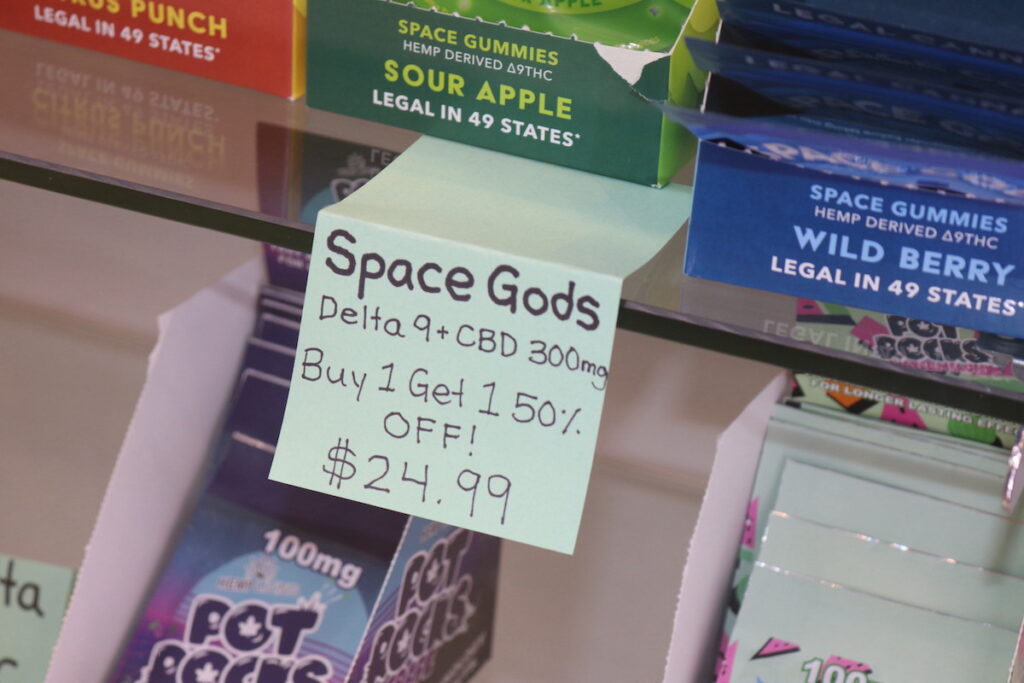
- No COA? Do not buy it. Vote with your wallet and don’t accept products which don’t prove what they’re providing. Our analysis shows that right now, you have about a 50/50 chance of being given less THC than you were promised. They need to prove their reliability.
- Be careful about dosage: Hemp products are only dose-limited if your state has brought in specific rules about it. This means you have to be very careful about dosage: 10 mg is the limit in most legal use states. Unless you have experience and know you can take more, use this as a guide.
- Pressure your politicians: Unfortunately the federal government has dumped a huge problem on the states, by legalizing hemp but not thinking the consequences through sufficiently. They do need to solve this problem, but might not see it as a priority. If you want your voice to be heard, send emails and attend any relevant open forum sessions. You have the right to get what you pay for and to be confident the products you can buy are safe. Politicians need to create those rules for the industry to follow.
Conclusion – The Loophole Will Close, but Hemp Delta-9 Will Stay
It’s clear that the current situation with hemp delta-9 can’t continue. Products are inaccurately labeled, can easily be purchased by minors, and all rest on a shady-sounding interpretation of what was a well-intentioned law. Legal cannabis industries feel like hemp companies get an easier ride, and lawmakers feel like they’ve snuck their intoxicating products in under the radar. States are already doing something, and although the FDA might not be in a rush, eventually they will do something.
But that doesn’t mean all is lost. In fact, with the majority of Americans favoring legalization and more and more states liberalizing their laws, as well as a booming CBD industry, it’s very unlikely that hemp delta-9 will be going anywhere. It’s more likely to have to deal with some harsher restrictions and likely limitations akin to those on THC edibles in legal states. If companies are smart, they’ll up their game ahead of the curve, and if not, many will undoubtedly fall.
Methodology
InfiniteCAL is a DCC and ISO/IEC 17025 accredited lab, and conducted all of the lab analysis for this report. Their full summary has more detail on the method, but the key points have been summarized below:
- Potency analysis: Cannabinoid concentrations are determined using ultra high performance liquid chromatography with a diode array detector (UHPLC-DAD). They perform regular calibration checks to ensure accuracy.
- Pesticide/mycotoxin analysis: These analyses are conducted through a combination of gas chromatography triple quad mass spectrometry (GC MS/MS) and liquid chromatography triple quad mass spectrometry (LC-MS/MS).
- Heavy metal analysis: Concentrations of arsenic, cadmium, mercury and lead are determined using inductively-coupled plasma mass spectrometry (ICP-MS).
- Residual solvent and terpene analysis: Both of these analyses are performed using headspace gas chromatography single quad mass spectrometry (HS-GC-MS).
- Microbial analysis: This is performed using real-time polymerase chain reaction (qPCR).
- Foreign material testing: This is done by eye and with a digital microscope.
- Moisture analysis: This is performed with a moisture analyzer, with loss of moisture calculated gravimetrically.
References
- Lauritzen, J. (2021). Marketing, Distribution, and Transportation of Hemp-Derived Products in Interstate Commerce. Trojan Horse Cannabis. Retrieved 26 April 2022, from https://trojanhorsecannabis.com/wp-content/uploads/2021/05/Legal-Opinion.pdf
- Kight, R., & Snow, P. (2021). Legal Status of Hemp-Derived Product Under Controlled Substances Act. Mr. Hemp Flower. Retrieved 26 April 2022, from https://mrhempflower.com/wp-content/uploads/2021/10/20210929.Mr-Hemp-Flower.Position-Statement-re-Delta-9-Gummy.pdf
- The Ottawa Hospital. (2022). Cannabis poisoning in young children increased nine times after legalization: Largest increase seen after legalization of commercial cannabis edibles. ScienceDaily. Retrieved April 26, 2022 from www.sciencedaily.com/releases/2022/01/220107121502.htm
- UDSA. (2021). Laboratory Testing Guidelines – U.S. Domestic Hemp Production Program. Retrieved 26 April 2022, from https://www.ams.usda.gov/sites/default/files/media/TestingGuidelinesforHemp.pdf
- Vaden, S. (2022). Legal Opinion on Certain Provisions of the Agriculture Improvement Act of 2018 Relating to Hemp. Washington, D.C.: USDA. Retrieved 26 April 2022 from https://www.ams.usda.gov/sites/default/files/HempExecSumandLegalOpinion.pdf
- FDA. (2021). FDA Regulation of Cannabis and Cannabis-Derived Products: Q&A. U.S. Food and Drug Administration. Retrieved 26 April 2022, from https://www.fda.gov/news-events/public-health-focus/fda-regulation-cannabis-and-cannabis-derived-products-including-cannabidiol-cbd#dietarysupplements
- NY Office of Cannabis Management. (2021). Cannabinoid Hemp Product Packaging and Labeling Checklist. Albany: Office of Cannabis Management. Retrieved 26 April 2022, from https://cannabis.ny.gov/system/files/documents/2021/11/cannabinoid_hemp_product_packaging_and_labeling_checklist_112321.pdf
- Oregan Health Authority. (2021). No Sales to Minors! – Change in Oregon law that restricts the sale of specific consumable hemp products to anyone under the age of 21. Oregon Health Authority. Retrieved 26 April 2022, from https://www.oregon.gov/olcc/marijuana/Documents/Fact_Sheets/No-Sales-to-Minors-THC.pdf
- Erickson, A. (2022). U.S. Hemp Roundtable Statement On the Marketing of Intoxicating Products Under the Guise of Hemp. US Hemp Roundtable. Retrieved 26 April 2022, from https://hempsupporter.com/news/u-s-hemp-roundtable-statement-on-the-marketing-of-intoxicating-products-under-the-guise-of-hemp
- Department of Cannabis Control. (2019). Reminder – Packaging and Labeling Compliance for Cannabis and Cannabis Products – Department of Cannabis Control. Department of Cannabis Control. Retrieved 26 April 2022, from https://cannabis.ca.gov/2019/06/reminder-packaging-and-labeling-compliance-for-cannabis-and-cannabis-products/
- Gobbi, G., Atkin, T., Zytynski, T., Wang, S., Askari, S., & Boruff, J. et al. (2019). Association of Cannabis Use in Adolescence and Risk of Depression, Anxiety, and Suicidality in Young Adulthood. JAMA Psychiatry, 76(4), 426. https://doi.org/10.1001/jamapsychiatry.2018.4500
- Memedovich, K., Dowsett, L., Spackman, E., Noseworthy, T., & Clement, F. (2018). The adverse health effects and harms related to marijuana use: an overview review. CMAJ Open, 6(3). https://doi.org/10.9778/cmajo.20180023
- Jacobus, J., & Tapert, S. (2014). Effects of Cannabis on the Adolescent Brain. Current Pharmaceutical Design, 20(13), 2186-2193. https://doi.org/10.2174/13816128113199990426
- Parolaro D. (2010). Consumo de cánnabis de los adolescentes y esquizofrenia: evidencias epidemiológicas y experimentales [Adolescent cannabis consumption and schizophrenia: epidemiological and experimental evidences]. Adicciones, 22(3), 185–189 https://pubmed.ncbi.nlm.nih.gov/20802980/
- Washington State Department of Agriculture. (2019). Testing Protocol for Identifying Delta-9 Tetrahydrocannabinol (THC) Concentration in Hemp. Washington State Department of Agriculture. Retrieved 26 April 2022, from https://cms.agr.wa.gov/getmedia/aac53423-716b-4ee0-b9a8-5929f51ab93d/811-TestingProtocolForDelta-9THCHemp
Related Media Coverage
- Nichols, K. (2022). As hemp THC sales boom online and by mail, cannabis industry braces for crackdown. MJ Biz Daily. Retrieved 26 April 2022, from https://mjbizdaily.com/as-hemp-thc-sales-boom-cannabis-industry-braces-for-crackdown/
- Cascio, J. (2021). The other delta variant: Delta 9 THC products gain popularity thanks to legal loophole. FOX 13 Tampa Bay. Retrieved 26 April 2022, from https://www.fox13news.com/news/the-other-delta-variant-delta-9-thc-products-gain-popularity-thanks-to-legal-loophole
- Gibson, M. (2021). How One Weed Company Is Skirting Marijuana Rules to Sell THC Products in All 50 States. Rolling Stone. Retrieved 26 April 2022, from https://www.rollingstone.com/culture/culture-features/delta-9-delta-8-thc-marijuana-hemp-1231832/
- Ruscitto, A. (2022). Delta-9 THC: The Latest Hemp-Derived Product Offering. Hemp Grower. Retrieved 26 April 2022, from https://www.hempgrower.com/article/delta-9-thc-edibles-the-latest-hemp-derived-product-offering/
- Williams, P. (2021). Delta-9 in Edible Hemp Products: What’s a ‘Dry Weight Basis’ Anyway?. Cannabis Business Times. Retrieved 26 April 2022, from https://www.cannabisbusinesstimes.com/article/delta-9-thc-edible-hemp-products-dry-weight-basis/
- Schaneman, B. (2022). Lack of standards, dubious business practices threaten to upend cannabis testing industry. MJ Biz Daily. Retrieved 26 April 2022, from https://mjbizdaily.com/lack-of-standards-dubious-business-practices-threaten-to-upend-cannabis-testing-industry/
- Kight, R. (2021). D9 is the New D8 or: How I Learned to Stop Worrying and Love Intoxicating Hemp. Kight on Cannabis. Retrieved 26 April 2022, from https://cannabusiness.law/d9-is-the-new-d8-or-how-i-learned-to-stop-worrying-and-love-intoxicating-hemp/
- Nichols, K. (2022). DEA goes to battle in federal court over THC in hemp extractions. MJ Biz Daily. Retrieved 26 April 2022, from https://mjbizdaily.com/dea-goes-to-battle-in-federal-court-over-thc-in-hemp-extractions/
- Hancock, L. (2022). Ohio medical marijuana regulators changing the definition of THC to include new cannabinoids and close loophole. Cleveland.com. Retrieved 26 April 2022, from https://www.cleveland.com/news/2022/04/ohio-medical-marijuana-regulators-changing-the-definition-of-thc-to-include-new-cannabinoids-and-close-loophole.html
Editor’s note: We made a minor revision to this report on November 18, 2022, to update the language that was used to explain potential discrepancies in lab results.
